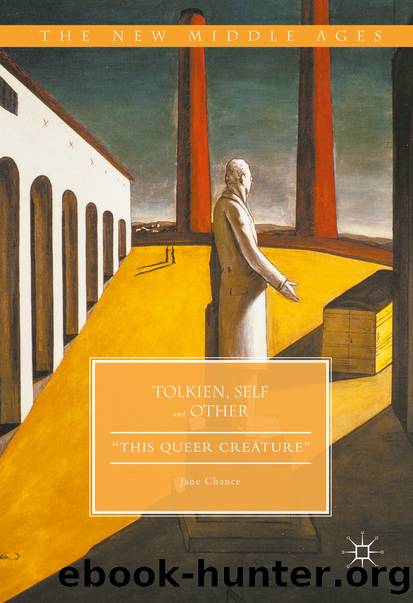Tolkien, Self and Other by Jane Chance

Author:Jane Chance
Language: eng
Format: epub
Publisher: Palgrave Macmillan US, New York
From these definitions and assumptions, one might surmise that the modern study of the medieval, as opposed to the study of the renaissance (a word Pugh and Weisl define in contrast to the medieval because of its renascent senses), equally involves not only the necessity of acquiring the knowledge of various languages to read the literature but also superfluous negative characterizations of those who perform that study.
Even though Tolkienâs interest in the Middle Ages clearly shaped his scholarly writing, it is not always as clear that this interest equally colored his fiction, although scholarship over the past thirty-five years has advanced many examples of how that works. That most general readers fail to see this medievalness is not so strange: our assumptions about fantasy, like Tolkienâs in âOn Fairy-Stories,â depend upon its usefulness as an escape from reality. There is, therefore, no necessary correlation between fantasy and the historical medieval. Further, many readers look for entertainment instead of meaning in fantasy, especially Tolkienâs. Yet, as John Clute and John Grant aptly note, in The Encyclopedia of Fantasy (1997), fantasy should be subversive: âIt could be argued that, if fantasy (and debatably the literature of the fantastic as a whole) has a purpose other than to entertain, it is to show readers how to perceive; an extension of the argument is that fantasy may try to alter readersâ perception of reality ⦠Most full fantasy texts have at their core the urge to change the reader; that is, full fantasy is by definition a subversive literary form.â 13
Tolkien, for whatever the reason, may have appeared to focus solely on his medieval study in his public professional practice and in scholarship. However, it is possible to discern the personal Tolkien even in the most scholarly of his articlesâand along with that, his desire to break down barriers between himself and others. That The Lord of the Rings offers to his readers the means of subverting or changing how they feel about serious issues becomes much clearer when we trace out what medieval works Tolkien himself was translating, reading, and continuing to teach while he was beginning to think about a sequel to The Hobbit, as early as the 1930s, if not before. In some of those medieval works, issues of race or class were being raised that would begin to be played out in the Germany that Adolf Hitler would make over into a playing field for the extermination of those who differed from the so-called Aryan ideal of the fair-haired: not only the Jews, but gypsies, homosexuals, and the disabled. This issue of racial and class difference must not have been unfamiliar to Tolkien as a South African-born professor who returned to Oxford to teach in 1925, but whose colleagues, even if similarly trained at Oxford or Cambridge, were for the most part born in England (certainly not Ireland or Scotland), and likely raised in upper-class families whose wealth accompanied their privilege. Certainly Tolkienâs closest friends were not necessarily upper classâhe partnered with his working-class student E.
Download
This site does not store any files on its server. We only index and link to content provided by other sites. Please contact the content providers to delete copyright contents if any and email us, we'll remove relevant links or contents immediately.
Anxious People by Fredrik Backman(2510)
The Last Thing He Told Me by Laura Dave(2165)
The Soulmate Equation by Christina Lauren(1892)
Not a Happy Family by Shari Lapena(1556)
Romancing Mr. Bridgerton (Bridgerton 04) by Julia Quinn(1501)
Slough House by Mick Herron(1388)
Life's Too Short by Abby Jimenez(1372)
The Switch by Beth O'Leary(1366)
Kiss My Cupcake by Helena Hunting(1323)
Solutions and Other Problems by Allie Brosh(1295)
Mordew by Alex Pheby(1249)
This Time Next Year by Sophie Cousens(1174)
A Rogue of One's Own by Evie Dunmore(1095)
No One Is Talking About This by Patricia Lockwood(1058)
The Mary Shelley Club by Goldy Moldavsky(1036)
Playing Nice by JP Delaney(1019)
Roadside Picnic by Arkadi & Boris Strugatsky(991)
Squeeze Me: A Novel by Carl Hiaasen(988)
Quinoterapia by Quino(976)
